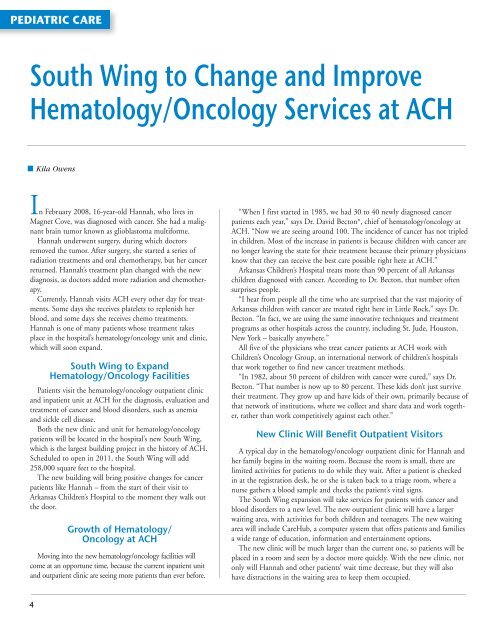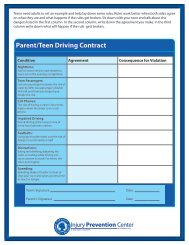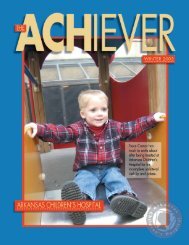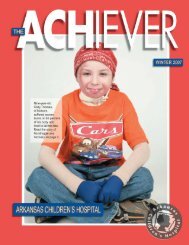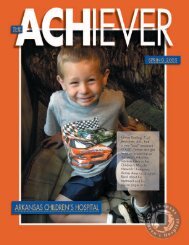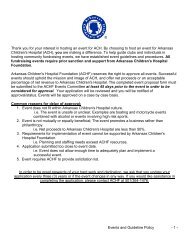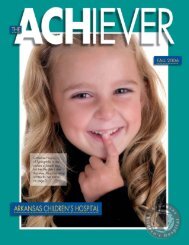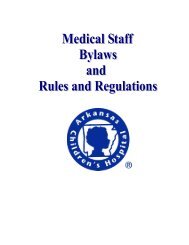Winter 2009 - Arkansas Children's Hospital
Winter 2009 - Arkansas Children's Hospital
Winter 2009 - Arkansas Children's Hospital
- No tags were found...
Create successful ePaper yourself
Turn your PDF publications into a flip-book with our unique Google optimized e-Paper software.
PEDIATRIC CARESouth Wing to Change and ImproveHematology/Oncology Services at ACH■ Kila OwensIn February 2008, 16-year-old Hannah, who lives inMagnet Cove, was diagnosed with cancer. She had a malignantbrain tumor known as glioblastoma multiforme.Hannah underwent surgery, during which doctorsremoved the tumor. After surgery, she started a series ofradiation treatments and oral chemotherapy, but her cancerreturned. Hannah’s treatment plan changed with the newdiagnosis, as doctors added more radiation and chemotherapy.Currently, Hannah visits ACH every other day for treatments.Some days she receives platelets to replenish herblood, and some days she receives chemo treatments.Hannah is one of many patients whose treatment takesplace in the hospital’s hematology/oncology unit and clinic,which will soon expand.South Wing to ExpandHematology/Oncology FacilitiesPatients visit the hematology/oncology outpatient clinicand inpatient unit at ACH for the diagnosis, evaluation andtreatment of cancer and blood disorders, such as anemiaand sickle cell disease.Both the new clinic and unit for hematology/oncologypatients will be located in the hospital’s new South Wing,which is the largest building project in the history of ACH.Scheduled to open in 2011, the South Wing will add258,000 square feet to the hospital.The new building will bring positive changes for cancerpatients like Hannah – from the start of their visit to<strong>Arkansas</strong> Children’s <strong>Hospital</strong> to the moment they walk outthe door.Growth of Hematology/Oncology at ACHMoving into the new hematology/oncology facilities willcome at an opportune time, because the current inpatient unitand outpatient clinic are seeing more patients than ever before.“When I first started in 1985, we had 30 to 40 newly diagnosed cancerpatients each year,” says Dr. David Becton*, chief of hematology/oncology atACH. “Now we are seeing around 100. The incidence of cancer has not tripledin children. Most of the increase in patients is because children with cancer areno longer leaving the state for their treatment because their primary physiciansknow that they can receive the best care possible right here at ACH.”<strong>Arkansas</strong> Children’s <strong>Hospital</strong> treats more than 90 percent of all <strong>Arkansas</strong>children diagnosed with cancer. According to Dr. Becton, that number oftensurprises people.“I hear from people all the time who are surprised that the vast majority of<strong>Arkansas</strong> children with cancer are treated right here in Little Rock,” says Dr.Becton. “In fact, we are using the same innovative techniques and treatmentprograms as other hospitals across the country, including St. Jude, Houston,New York – basically anywhere.”All five of the physicians who treat cancer patients at ACH work withChildren’s Oncology Group, an international network of children’s hospitalsthat work together to find new cancer treatment methods.“In 1982, about 50 percent of children with cancer were cured,” says Dr.Becton. “That number is now up to 80 percent. These kids don’t just survivetheir treatment. They grow up and have kids of their own, primarily because ofthat network of institutions, where we collect and share data and work together,rather than work competitively against each other.”New Clinic Will Benefit Outpatient VisitorsA typical day in the hematology/oncology outpatient clinic for Hannah andher family begins in the waiting room. Because the room is small, there arelimited activities for patients to do while they wait. After a patient is checkedin at the registration desk, he or she is taken back to a triage room, where anurse gathers a blood sample and checks the patient’s vital signs.The South Wing expansion will take services for patients with cancer andblood disorders to a new level. The new outpatient clinic will have a largerwaiting area, with activities for both children and teenagers. The new waitingarea will include CareHub, a computer system that offers patients and familiesa wide range of education, information and entertainment options.The new clinic will be much larger than the current one, so patients will beplaced in a room and seen by a doctor more quickly. With the new clinic, notonly will Hannah and other patients’ wait time decrease, but they will alsohave distractions in the waiting area to keep them occupied.4


